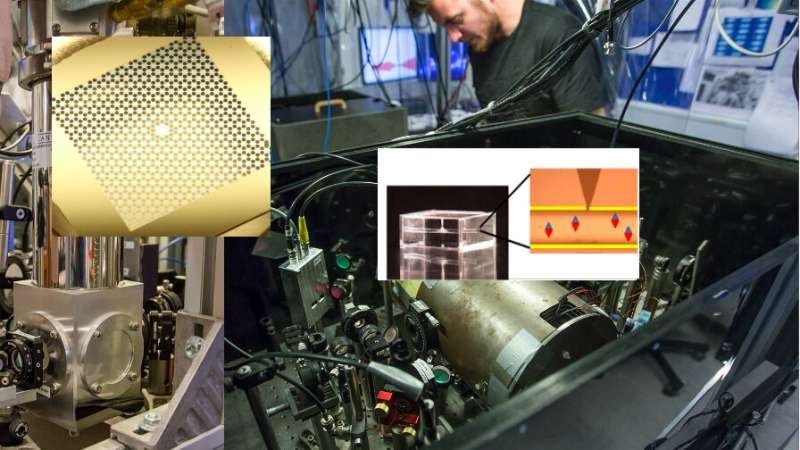October 27, 2020 feature
The experimental demonstration of entanglement between mechanical and spin systems

Quantum entanglement is the basic phenomenon underlying the functioning of a variety of quantum systems, including quantum communication, quantum sensing and quantum computing tools. This phenomenon results from an interaction (i.e., entanglement) between particles. Attaining entanglement between distant and very different objects, however, has so far proved highly challenging.
Researchers at the University of Copenhagen have recently generated entanglement between a mechanical oscillator and a collective atomic spin oscillator. Their work, outlined in a paper published in Nature Physics, introduces a strategy for generating entanglement between these two distinct systems.
"About a decade ago, we proposed a way to generate entanglement between a mechanical oscillator and a spin oscillator via photons, using the principle that was later called 'quantum mechanics free subspaces' or 'trajectories without quantum uncertainties,'" said Eugene S. Polzik, who led the group that carried out the study. "In our new paper, we report experimental implementation of these proposals."
To generate entanglement between a mechanical and a spin system, Polzik and his colleagues leveraged a key feature of spin oscillators, namely that they can have an effective negative mass. When it is excited, a spin oscillator's energy is reduced, which allows it to become entangled with a more conventional mechanical oscillator that has a positive mass. The researchers experimentally generated this entanglement by performing a joint measurement on both oscillators.
"Entanglement between the mechanical and spin systems is generated by sending light through both systems, a positive mass mechanical oscillator and a spin oscillator with an effective negative mass," Polzik said. "Performing a measurement on the transmitted light projects the two systems into an entangled state. Subsequent repeated measurement verifies the entanglement by showing that the quantum fluctuations of the two systems are strongly correlated."
The experiment carried out by Polzik and his colleagues shows that mechanical motion can, at least in principle, be measured with arbitrary accuracy by identifying and applying a suitable reference frame. These measurements overcome the so-called 'standard quantum limit of measurement' that derives from the Heisenberg uncertainty principle, which is applicable to measurements in a standard, classical reference frame.
"The essence of the uncertainty principle is the balance between the imprecision of measurement and the disturbance caused by the measurement, the quantum back action," Polzik said. "With a measurement in the negative mass reference frame the backaction disturbances imposed on the object and on the reference frame interfere distractively and cancel out, thus leading to potentially unlimited measurement accuracy."
This team of researchers was the first to experimentally demonstrate entanglement between a mechanical and a spin system. In the future, their work could contribute to the development of new quantum technologies and protocols that are based on entanglement between different types of oscillators. In their next studies, Polzik and his colleagues plan to evaluate the effectiveness of their approach for performing quantum teleportation and to develop other quantum communication tools.
"With the recent observation of quantum back action by the gravitational wave detectors' teams LIGO and VIRGO the ways to overcome the quantum back action limits become especially relevant for those extremely challenging instruments," Polzik said. "We are constructing an experiment where we intend to demonstrate potential applicability of our approach to the improved sensitivity of gravitational wave detectors."
More information: Entanglement between distant macroscopic mechanical and spin systems. Nature Physics (2020). DOI: 10.1038/s41567-020-1031-5.
Journal information: Nature Physics
© 2020 Science X Network




















